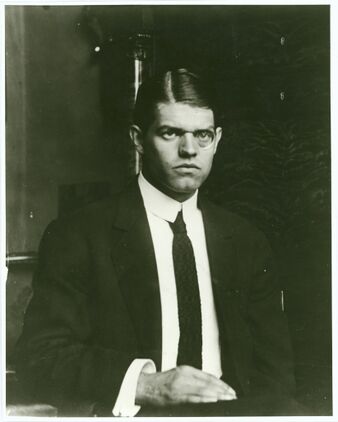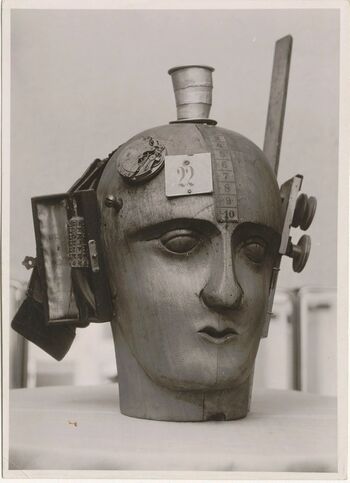Raoul Hausmann
 Raoul Hausmann in 1915 | |
| Born |
July 12, 1886 Vienna, Austria-Hungary (today Austria) |
|---|---|
| Died |
February 1, 1971 (aged 84) Limoges, France |
| Web | UbuWeb Sound, Dada Companion, Wikipedia |
| Collections | Berlinische (selection) |


Raoul Hausmann (1886–1971) was an Austrian artist and writer. One of the key figures in Berlin Dada, his experimental photographic collages, sound poetry and institutional critiques would have a profound influence on the European Avant-Garde in the aftermath of World War I.
Contents
Life and work[edit]
Raoul Hausmann was born on 12 July 1886, in Vienna, to Gabriele Hausmann, née Petke, and the Hungarian portrait and history painter Victor Hausmann. In 1900, at the age of fourteen, Hausmann moved with his family to Berlin, where he undertook his first artistic studies under the tutelage of his father. In 1905 Hausmann met Johannes Baader as well as his future wife, the violinist Elfriede Schaeffer. After the birth of their daughter Vera in 1907, Hausmann married Schaeffer in 1908. Between 1908 and 1911 Hausmann enrolled at Arthur Lew-Funcke's Atelier for Painting and Sculpture in Berlin-Charlottenburg, one of the many private art schools in the city, where he studied anatomy and nude drawing. He worked on his first typographical designs as well as glass window designs between 1909 and 1914, and assisted his father with the restoration of murals in the Hamburg city hall in 1914. In 1915 Raoul Hausmann began an extramarital affair with the artist Hannah Höch, forming an artistically productive yet turbulent bond that would last until 1922.
Hausmann's encounters with expressionist painting in 1912, which he saw in Herwarth Walden's avant-garde Sturm Gallery, proved pivotal for his artistic development. He produced his first expressionist lithographs and woodcuts in expressionist painter Ernst Heckel's atelier and published his first polemical texts against the art establishment in Walden's magazine, also named Der Sturm. Hausmann remained active in expressionist circles well into 1917, publishing two essays concerned with the relationship between artistic production, human subjectivity, and the spirit in Franz Pfemfert's Die Aktion, a journal known for its leftist, antimilitaristic stance.
As an Austrian-born citizen living in Germany, Hausmann was not drafted into military service and thus was spared the shattering war experiences that affected so many of his peers. Yet his initial attitude toward the war was characteristic of the expressionist generation in that he believed the devastation on the battlefields held promise of a vital future, destroying calcified Wilhelminian social structures and clearing the way for a new world. In 1916 Hausmann met the two men whose radicalism nourished this idea of a new beginning, namely the psychoanalyst Otto Gross, who considered psychoanalysis to be preparatory work for a revolution, and the anarchist expressionist writer Franz Jung, who was a disciple of Gross and avid reader of Walt Whitman. Inspired by the work of Gross and Jung, as well as the writings of Whitman and Friedrich Nietzsche, Hausmann understood himself to be a pioneer for the birth of the new man. The notion of destruction as an act of creation was the point of departure for Hausmann's Dadasophy, his theoretical contribution to Berlin Dada.
As Dadasoph, and cofounder of Club Dada in Berlin, Hausmann wrote several key Dada texts, including the "Dadaist Manifesto" with Richard Huelsenbeck and the sixteen-page Club Dada brochure with Jung and Huelsenbeck. He also edited the journal Der Dada. From 1919 onward, Hausmann prepared the big world atlas Dadaco, though the project fell through due to editorial difficulties. In addition Hausmann played a central role in organizing Dada events, including the First International Dada Fair with John Heartfield and George Grosz and numerous Dada matinees and soirées in Berlin, often in collaboration with Johannes Baader, and six tours from January to March 1920, traveling together with Baader and Huelsenbeck to Dresden, Hamburg, Leipzig, Teplitz, Schönau, Prague, and Karlsbad.
Hausmann's artistic contributions to Dada were purposefully eclectic, consistently blurring the boundaries between visual art, poetry, music, and dance. His "optophonetic" poems of early 1918 fused lyrical texts with expressive typography, insisting on the role of language as both visual and acoustic.
Boisterous public performances of these poems not only underscored their vocal dimension but also transformed their two-dimensionality into a bodily experience. After August 1918 Hausmann incorporated collage elements into his work, influenced by the photomontages from the front that he saw while on vacation with Hannah Höch. By 1920 Hausmann had manufactured several reliefs and assemblages, only one of which survives, the Mechanischer Kopf [Mechanical Head].
After his engagement with Dada, Hausmann focused primarily on photography, producing portraits, nudes, and landscapes. Hausmann left Germany in 1933, emigrating to Ibiza where his photographs reflected a romantic yearning for origins, focusing on ethnographic and architectural motifs of premodern life in Ibiza. From 1939 to 1944, Hausmann lived illegally in Peyrat-le-Château, France, with his Jewish wife Hedwig, née Mankiewitz. He published books and essays on Dada after the war, including Courier Dada, 1958, and Am Anfang War Dada [At the Beginning Was Dada], 1972. Raoul Hausmann died on 1 February 1971, in Limoges, France. (Source)
Publications[edit]
- Hurra! Hurra! Hurra! 12 Satiren, Berlin: Malik, 1921, 45 pp, KHZ. (German)
- "Présentismus: gegen den Puffkeïsmus der teutschen Seele", De Stijl 4, Leiden: De Stijl, 1921, pp 136-143, KHZ, IDA. (German)
- Courrier Dada, suivi d'une biobibliographie de l'auteur, Paris: Le Terrain Vague, 1958, 157 pp; new ed. as Courrier Dada, Paris: Allia, 1992, 239 pp; new ed., Paris: Allia, 2004, 188 pp. (French)
- with Iliazd, Poèmes et bois, Paris: Degré Quarante et Un, 1961, [8] pp, KHZ. (French)
- Sprechspäne, Flensburg: Petersen, 1962. (German)
- Mélanographie, Jean Petithory, 1968, [24] pp, KHZ. (French)
- Hyle: ein Traumsein in Spanien, Frankfurt am Main: Heinrich-Heine-Verlag, 1969, 196 pp; new ed., ed. & afterw. Adelheid Koch-Didier, Munich: Belleville, 2006. Autobiographical novel. (German)
- Hyle: ser-sueño en España, trans. Nieves Trabanco, intro. Emiliano Fernández, Gijón: Trea, 1997, 283 pp. (Spanish)
- Hylé. État de rêve en Espagne, trans. Hélène Thiérard, postf. Adelheid Koch-Didier, Dijon: Les Presses du réel, 2013, 385 pp. (French)
- Raoul Hausmann et Dada à Berlin: notes, documents et témoignages inédits, eds. Roberto Altmann and Jean François Bory, Vaduz: Centre d'Art et Communication, 1974, 84 pp. (French)
- Texte bis 1933. Band 1, Bilanz der Feierlichkeit, ed. Michael Erlhoff, Munich: text + kritik, 1982, 224 pp. (German)
- Texte bis 1933. Band 2, Sieg Triumph Tabak mit Bohnen, ed. Michael Erlhoff, Munich: text + kritik, 1982, 240 pp. (German)
- Geist im Handumdrehen, eds. Uta Brandes and Michael Erlhoff, Hamburg: Nautilus, and Zürich: Moderne, 1989, 62 pp. (German)
- "Je suis l'homme de 5000 paroles et de 10000 formes": écrits de Raoul Hausmann et de documents annexes, ed. & notes Adelheid Koch-Didier, Rochechouart: Musée départemental de Rochechouart, 1997, xiii+230 pp. (French)
- Umbruch, ed. & afterw. Adelheid Koch, Innsbruck: Haymon, 1997, 127 pp. (German)
- La sensorialité excentrique 1968-69, précédée de Optophonétique 1922, Henri Chopin (OU), 1970, 69 pp.
- No 1, La sensorialidad excentrica 1968-69: precedida de Optofonetica 1922, Madrid: Tres Catorce Diecisiete, 1975. (Spanish)
- La sensorialité excentrique. Die exzentrische Empfindung, ed. & afterw. Adelheid Koch, Graz: Droschl, 1994, 116 pp. (French)/(German)
- Sensorialité excentrique. Eccentric Sensoriality, Dijon: Presses du Réel, 2002, 123 pp. (French)/(English)
- Scharfrichter der bürgerlichen Seele: Raoul Hausmann in Berlin 1900–1933. Unveröffentlichte Briefe, Texte, Dokumente aus den Künstler-Archiven der Berlinischen Galerie, ed. Eva Züchner, Ostfildern: Hatje, 1998. (German)
- Une anthologie poétique, Marseille: Al Dante: Transbordeurs, 2007, 261 pp. With audio CD. (French)
- Dada-Wissenschaft. Wissenschaftliche und technische Schriften, ed. Arndt Niebisch, Hamburg: Philo Fine Arts, 2010, 350 pp. (German)
- Photographisches Sehen. Schriften zur Photographie 1921-1968, eds. Bernd Stiegler and Thomas Köhler, Paderborn: Fink, 2016, 545 pp. [2] (German)
Literature[edit]
- Timothy O. Benson, Raoul Hausmann and Berlin Dada, Ann Arbor, MI: UMI Research Press, 1987, xvi+280 pp, OL. (English)
- Eva Züchner, Kurt Schwitters und Raoul Hausmann schreiben im Kino eine Oper, Berlin: Berlinische Galerie, 2001, 87 pp. (German)
- Arndt Niebisch, "Ether Machines: Raoul Hausmann’s Optophonetic Media", in Vibratory Modernism, eds. Anthony Enns and Shelley Trower, Palgrave Macmillan, 2013, pp 162-176. (English)
